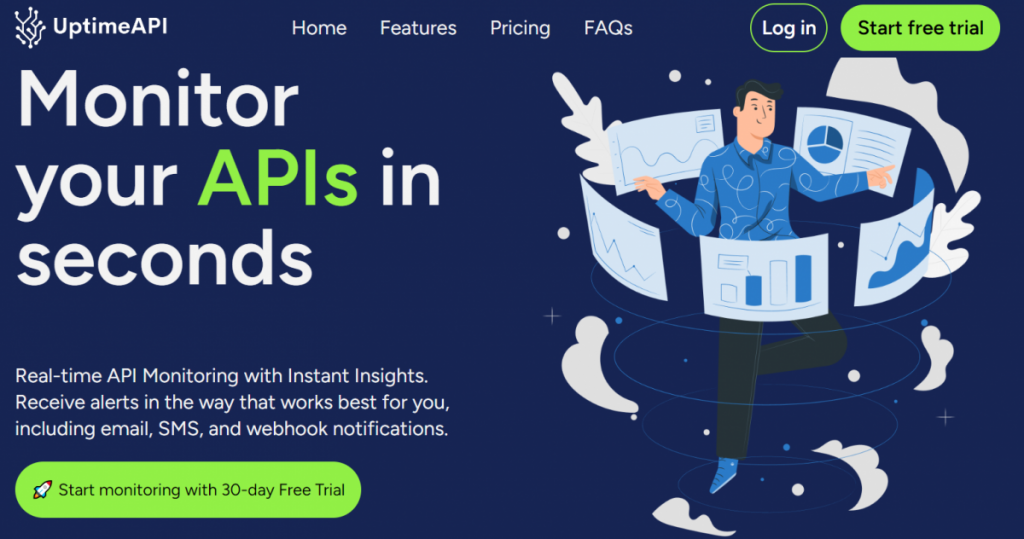In the fast-paced world of cloud computing, ensuring the reliability and performance of your APIs is paramount. Downtime can lead to frustrated users, lost revenue, and damaged reputation. To address these concerns, a robust API monitoring solution becomes essential. Enter UptimeAPI – a cutting-edge tool designed to empower businesses with real-time insights into the health of their APIs. In this article, we’ll explore the significance of cloud API monitoring, the key features of UptimeAPI, and what you can expect from its API responses.
The Importance of Cloud API Monitoring

As businesses increasingly rely on cloud services, the need for efficient API monitoring becomes more critical. APIs serve as the backbone of modern applications, enabling seamless communication between different software components. Monitoring these APIs in real-time helps identify issues before they escalate, ensuring a smooth user experience.
1. Proactive Issue Resolution
UptimeAPI allows you to proactively detect potential issues before they impact your users. By continuously monitoring your APIs, you can identify performance bottlenecks, server errors, and other issues that might otherwise go unnoticed.
2. Improved User Experience
Downtime or slow response times can lead to a poor user experience. UptimeAPI helps you maintain optimal API performance, resulting in faster response times and a more satisfying experience for your users.
3. Data-Driven Decision Making
Monitoring your APIs with UptimeAPI provides valuable data and insights. Analyzing trends and patterns in API performance allows for informed decision-making, enabling you to optimize resources and enhance overall system efficiency.
Exploring UptimeAPI’s Features

Real-time Monitoring
UptimeAPI offers real-time monitoring capabilities, allowing you to track the performance of your APIs with precision. Receive instant alerts for any anomalies, ensuring that you can address issues promptly.
Customizable Dashboards
Tailor your monitoring experience with UptimeAPI’s customizable dashboards. Display the metrics that matter most to your business, providing a clear and comprehensive view of your API performance.
Historical Data Analysis
Understanding the historical performance of your APIs is crucial for identifying patterns and trends. UptimeAPI stores historical data, enabling you to conduct in-depth analysis and make informed decisions based on past performance.
Integration with Popular Cloud Providers
UptimeAPI seamlessly integrates with major cloud providers, including AWS, Azure, and Google Cloud. This ensures that you can monitor APIs across diverse environments, offering flexibility for businesses with multi-cloud strategies.
API Response: What to Expect
When integrating UptimeAPI into your system, it’s essential to understand the nature of API responses. UptimeAPI provides comprehensive and standardized responses that empower developers with the information needed to maintain and optimize API performance.
1. Status Code
The status code is a fundamental component of UptimeAPI’s response. It indicates whether the API request was successful or encountered an error. Common HTTP status codes, such as 200 for success and 4xx or 5xx for errors, provide a quick overview of the request’s outcome.
2. Response Time
UptimeAPI provides the response time for each API request. This metric is crucial for assessing the performance of your APIs. A lower response time indicates efficient API processing and contributes to a smoother user experience.
3. Error Details
In the event of an error, UptimeAPI offers detailed error information in the response. This includes error codes, descriptions, and timestamps, facilitating rapid diagnosis and resolution of issues.
4. Historical Performance Metrics
Beyond individual API responses, UptimeAPI includes historical performance metrics in its responses. This data allows you to track performance trends over time, aiding in the identification of long-term issues or opportunities for optimization.
Getting Started with UptimeAPI
Now that you understand the importance of cloud API monitoring and the key features of UptimeAPI, it’s time to take the first step. Getting started with UptimeAPI is a straightforward process:
1. Sign Up for an Account
Visit the UptimeAPI website and sign up for a free account. The user-friendly onboarding process will guide you through the initial setup.
2. Configure API Endpoints
Add the API endpoints you want to monitor. UptimeAPI supports various protocols, including HTTP, HTTPS, and more, ensuring compatibility with your specific requirements.
3. Customize Monitoring Settings
Tailor the monitoring settings to align with your business needs. Set up alert thresholds, frequency of checks, and other parameters to ensure that UptimeAPI aligns with your unique use case.
4. Integrate with Your System
Follow the integration guidelines provided by UptimeAPI to seamlessly connect it with your existing systems. UptimeAPI offers robust documentation and support to facilitate a smooth integration process.
Conclusion
In the dynamic landscape of cloud computing, ensuring the reliability and performance of your APIs is non-negotiable. UptimeAPI emerges as a powerful solution, combining real-time monitoring, customizable dashboards, historical data analysis, and seamless integration with major cloud providers. By understanding the API responses provided by UptimeAPI, developers can leverage this tool to maintain optimal API performance and deliver an exceptional user experience. Don’t wait – embark on your cloud API monitoring journey with UptimeAPI today and elevate your digital infrastructure to new heights.
Read More: Company profile APIUsage Cases

